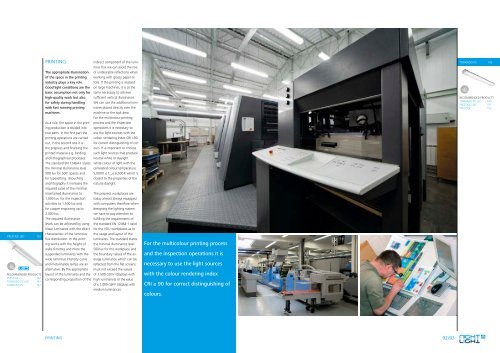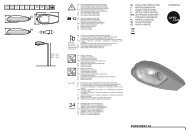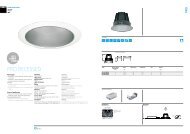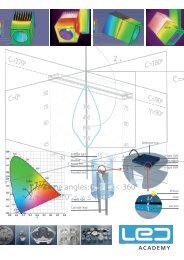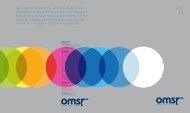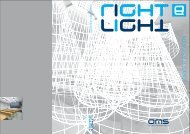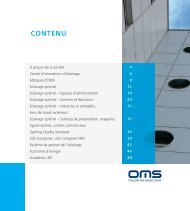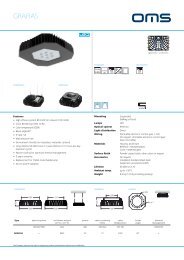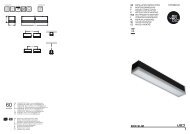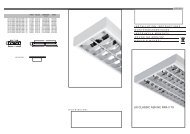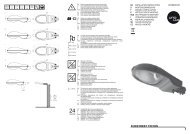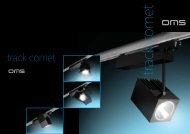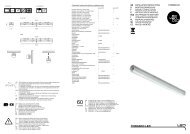Download PDF Catalogue - OMS lighting
Download PDF Catalogue - OMS lighting
Download PDF Catalogue - OMS lighting
You also want an ePaper? Increase the reach of your titles
YUMPU automatically turns print PDFs into web optimized ePapers that Google loves.
PRESTIGE LED 151<br />
RECOMMENDED PRODUCTS<br />
PRESTiGE 152<br />
tornado PC LED 147<br />
tornado PC 147<br />
Printing<br />
The appropriate illumination<br />
of the space in the printing<br />
industry plays a key role.<br />
Good light conditions are the<br />
basic assumption not only for<br />
high-quality work but also<br />
for safety during handling<br />
with fast running printing<br />
machines.<br />
As a rule, the space in the printing<br />
production is divided into<br />
two parts. In the first part the<br />
printing operations are carried<br />
out, in the second one it is<br />
the prepress and finalising the<br />
printed material e.g. binding<br />
and lithographical processes.<br />
The standard EN 12464-1 states<br />
the minimal illuminance level<br />
500 lux for both spaces and<br />
for typesetting, retouching<br />
and litography it increases the<br />
required value of the minimal<br />
maintained illuminance to<br />
1,000 lux, for the inspection<br />
activities to 1,500 lux and<br />
for copper engraving up to<br />
2,000 lux.<br />
The required illuminance<br />
levels can be achieved by using<br />
linear luminaires with the direct<br />
characteristic of the luminous<br />
flux distribution. In the printing<br />
works with the height of<br />
walls 6 metres and more the<br />
suspended luminaires with the<br />
wide luminous intensity curve<br />
and metal-halide lamps are an<br />
alternative. By the appropriate<br />
layout of the luminaires and the<br />
corresponding proportion of the<br />
indirect component of the luminous<br />
flux we can avoid the rise<br />
of undesirable reflections when<br />
working with glossy paper or<br />
foils. If the printing is realised<br />
on large machines, it is at the<br />
same necessary to achieve<br />
sufficient vertical illuminance.<br />
We can use the additional luminaires<br />
placed directly over the<br />
machine or the task area.<br />
For the multicolour printing<br />
process and the inspection<br />
operations it is necessary to<br />
use the light sources with the<br />
colour rendering index CRI >90<br />
for correct distinguishing of colours.<br />
It is important to choose<br />
such light sources that produce<br />
neutral white or daylight<br />
white colour of light with the<br />
correlated colour temperature<br />
5,000 K ≤ T CP<br />
≤ 6,500 K which is<br />
closest to the properties of the<br />
natural daylight.<br />
The prepress workplaces are<br />
today almost always equipped<br />
with computers therefore when<br />
designing the <strong>lighting</strong> system<br />
we have to pay attention to<br />
fulfilling the requirements of<br />
the standard EN 12464-1 valid<br />
for the VDU workplaces as to<br />
the usage and layout of the<br />
luminaires. The standard states<br />
the minimal illuminance level<br />
500 lux for this workplace and<br />
the boundary values of the average<br />
luminance which can be<br />
reflected from the flat screens<br />
must not exceed the values<br />
of 1,500 cd/m 2 (displays with<br />
high luminance) or the value<br />
of ≤ 1,000 cd/m 2 (displays with<br />
medium luminance).<br />
For the multicolour printing process<br />
and the inspection operations it is<br />
necessary to use the light sources<br />
with the colour rendering index<br />
CRI ≥ 90 for correct distinguishing of<br />
colours.<br />
TORNADO PC 143<br />
RECOMMENDED PRODUCTS<br />
tornado PC LED 143<br />
PRESTige LED 151<br />
PRESTige 152<br />
Printing<br />
92/93


